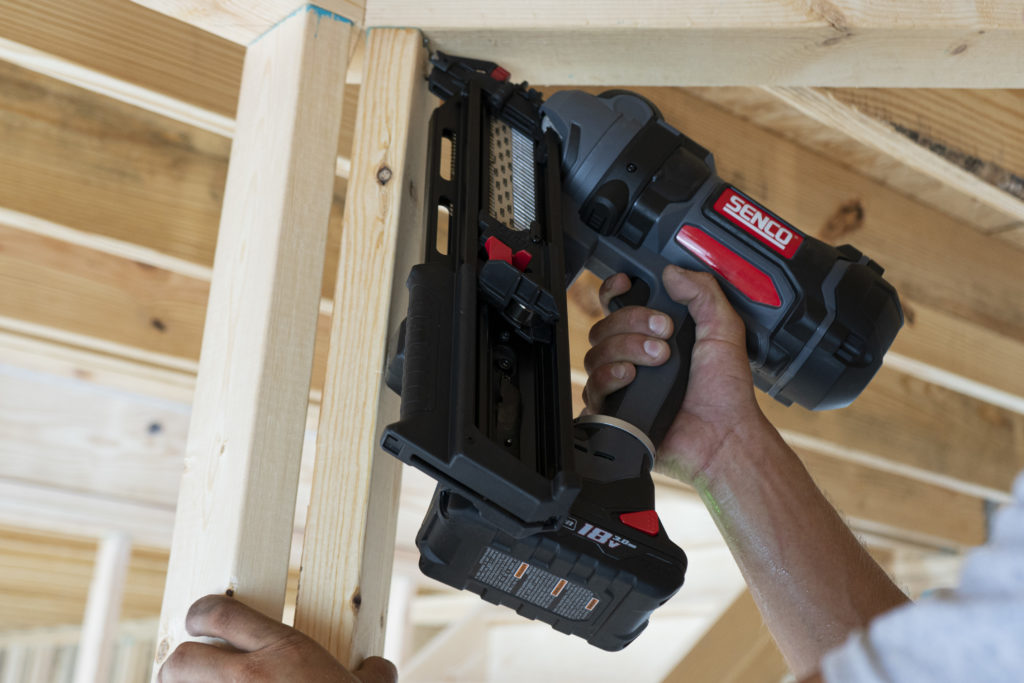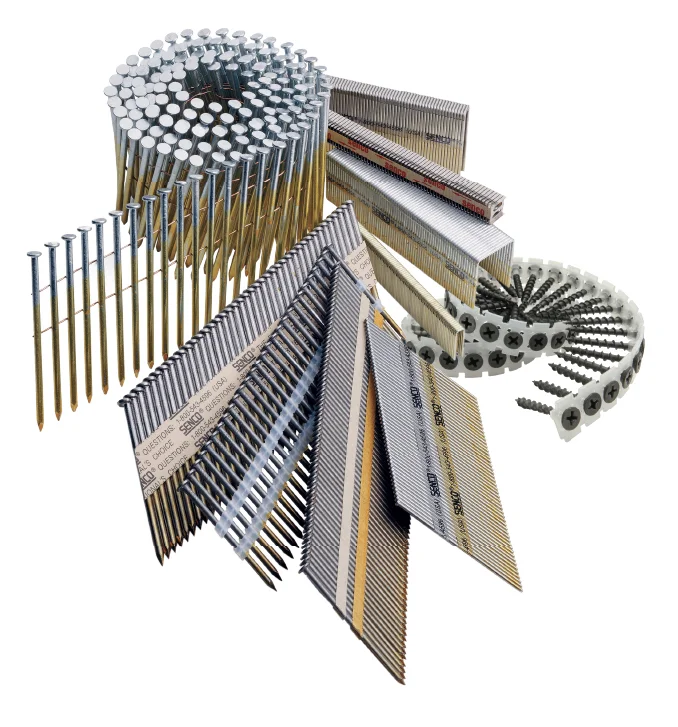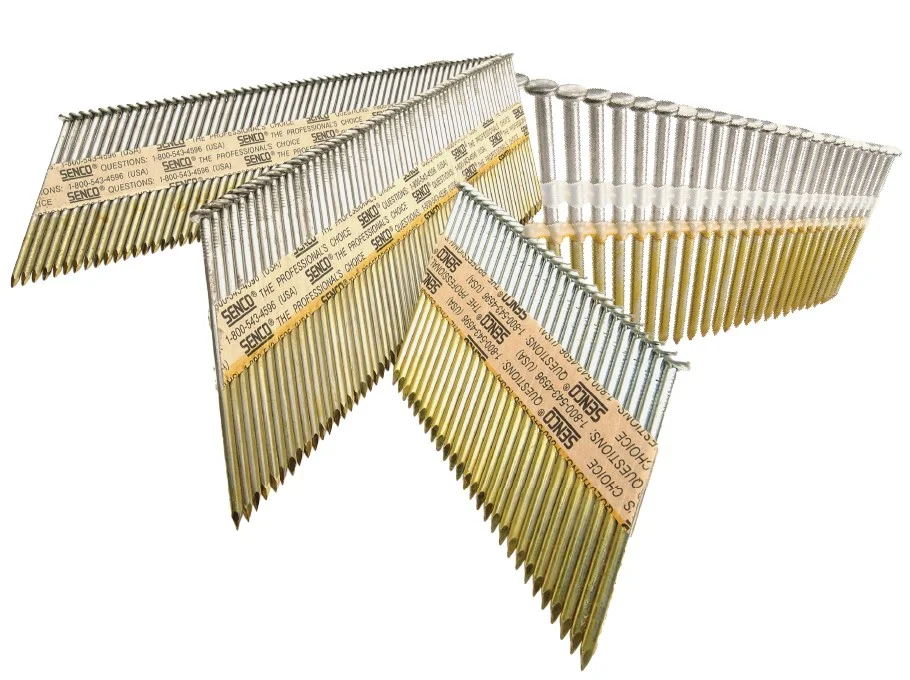How Do Cordless Nailers Work?

Breaking Down Which Cordless Nail Gun Technology is Best
Most cordless power tools, such as drills or circular saws, are simple to understand. A battery produces electrical energy that powers a motor. The rotation of the motor creates the drilling or sawing motion of the tool.
However, battery-powered nail and staple guns don’t use rotational force to get the job done. Instead, nailers use electricity primarily to store or ignite a secondary energy source. That second energy source – for example, compressed air – provides the driving force in a nailer.
There are three common types of cordless nailer. All of them use a battery and all of them drive nails, but the similarities end there. Each type of cordless nailer technology stores and releases energy in a different way, and each method has its own unique strengths and drawbacks.
Here is an overview of the three primary types of cordless nailer technology:
CORDLESS PNEUMATIC NAILERS
SENCO invented cordless pneumatic technology when it launched FUSION technology in 2010. It was the first battery nailer to be powered by compressed air, just like a traditional corded nail gun. However, unlike a traditional nailer, there is no air compressor required. The onboard air cylinder is permanently sealed at the factory or service center.
When the tool’s trigger is pulled, the piston and driver blade assembly is released. The force of the compressed air on the piston/driver propels it forward to drive the fastener. After each shot, the tool’s battery powers a motor that resets the piston and recompresses the air.
Benefits
There are many benefits to cordless pneumatic technology like SENCO’s FUSION. SENCO cordless nailers feel and perform like traditional pneumatic nail guns, which contractors and craftsmen have relied on for decades. Cordless pneumatic nailers are nearly indistinguishable from traditional nailers in terms of speed – the motor recompresses air in a fraction of a second, resulting in no delay between shots, even when bump firing. Additionally, these nailers are powerful enough to consistently sink nails in dense materials like engineered lumber. Cordless pneumatic nailers don’t exhaust air or hazardous fumes.
Drawbacks
Due to the battery and durable components, cordless pneumatic nailers may be somewhat heavier than gas nailers, although a well-balanced, ergonomic tool minimizes fatigue. Some types of cordless pneumatic nailers may be difficult to repair due to components being housed in a pressurized air cylinder. (New SENCO FUSION nailers include a pressure relief and refill valve so service centers can quickly and safely depressurize tools for maintenance.)
GAS NAILERS
Gas nailers have as much in common with a combustion engine as a traditional pneumatic nailer. Rather than using air to drive nails, gas nailers use replaceable fuel cartridges that contain a flammable gas, like butane. A small fan mixes gas and air in a reservoir on the tool, and a spark from the battery ignites the mixture.
Force from the internal combustion process powers the piston and driver blade that drives the nail. After each shot, as the tool exhausts and the changes in air pressure reset the piston. Air and butane are mixed again to prepare for the next shot.
Benefits
Because gas nailers use electricity to power a small fan and a spark plug rather than complex motors that store energy, batteries tend to be smaller. Larger batteries account for much of a cordless tools’ weight, so gas nailers tend to be lighter than cordless pneumatic or spring-loaded nailers. Internal combustion provides plenty of power for sinking nails in engineered lumber.
Drawbacks
The cost of fuel cartridges add up over time – fuel costs can be nearly $20 per 1,200 nails. Gas nailers should only be used outdoors or in well-ventilated spaces due to the fumes they can emit. Additionally, most gas nailers don’t allow users to bump fire, which can slow down certain jobs in which a lot of nails have to be placed quickly. Internal combustion creates soot and deposits within the tool, which require them to be disassembled, cleaned and maintained regularly. Fuel cells become less reliable in cold weather.
FLYWHEEL NAILERS
Flywheel nailers are the most similar to other types of cordless tools, like drills. The battery powers a motor that rotates a flywheel when the trigger is held. As the flywheel builds up speed, it stores energy, which is then transferred to the piston and driver assembly when the nose is depressed. Springs then return the piston to the ready position to fire the next nail. Flywheel nailers have a lot of moving parts and are the most complex of any type of battery-powered nail gun.
Benefits
Like cordless pneumatic nailers, flywheel nailers don’t require fuel cells to operate. Depending on the brand you choose, they may work with batteries you already use on other types of power tools. These tools bump fire relatively quickly, as holding the trigger down keeps the flywheel spinning and generating energy.
Drawbacks
Generally, flywheel nailers tend to be the slowest-firing of the three common types of cordless tools, particularly when users aren’t bump-firing. The first shot requires a second or two of ramp-up time for the flywheel to speed up and build energy. Every time the trigger is released, this process begins again. The complexity of the tool’s internal components make repair difficult. Getting a flywheel nailer repaired typically requires mailing it back to the manufacturer for a period of time. Many flywheel nailers don’t have the power to sink nails in dense material like engineered lumber. The spinning flywheel also creates a gyroscopic effect, which can affect the user comfort and ability to accurately drive fasteners
SPECIALTY NAILERS
Some types of cordless nailers don’t use a battery. These nailers are typically used for highly specialized applications. For example, powder-actuated nailers used a cartridge filled with black powder that is ignited when a striker hits the rim of the cartridge. These types of nailers produce a considerable amount of power – so much so that they are only useful for fastening material to steel or concrete. Additionally, some handheld, spring-loaded finish nailers – similar to small staple guns – use manual force from the user to power a spring-loaded striker that drives nails. These nailers don’t pack much power and are typically only used for soft materials.
For a true cordless nailer with a wide variety of uses, you will likely require a battery-powered tool and one of the three technologies above. Cordless pneumatic nailers are most similar to traditional pneumatic nailers and have the fewest drawbacks.

